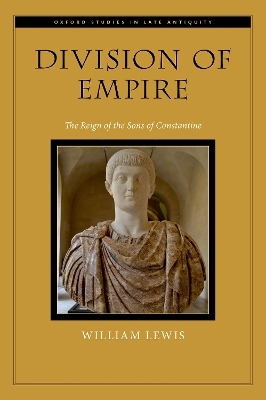
Division of Empire
The Reign of the Sons of Constantine
Seiten
2024
Oxford University Press Inc (Verlag)
978-0-19-774514-4 (ISBN)
Oxford University Press Inc (Verlag)
978-0-19-774514-4 (ISBN)
- Lieferbar (Termin unbekannt)
- Versandkostenfrei innerhalb Deutschlands
- Auch auf Rechnung
- Verfügbarkeit in der Filiale vor Ort prüfen
- Artikel merken
Constantine the Great died on May 22nd in 337 AD, leaving behind three sons--Constantine II, Constantius II, and Constans--to face the challenge of how to rule the Roman Empire. Division of Empire follows the lives of these brothers, beginning with the death of their father, and traces how they first shared the empire as a triarchy, until one by one the heirs of Constantine fell to the sword. Constantine II was killed by his brother Constans in the civil war of 340, and Constans was murdered by a usurper in 350. Constantius was the last man standing of Constantine's sons, and he reunified the empire under the rule of a sole Augustus, like his father. However, the cracks were already starting to show, and his efforts at reunification would soon prove to be a failure.
It is well known that the Roman Empire came to be divided into eastern and western halves in 395, but what is less known is that this was the culmination of a series of smaller fractures, divisions, and then attempts at reunifications that stretched across the fourth century. Division was a process, rather than a singular event, and it is a process that has, until now, received little scholarly attention. William Lewis uses this story of family massacres, civil wars, assassinations, usurpations, and desperate armed struggles for power as a case study for division and an original reappraisal of politics in the mid-fourth century.
It is well known that the Roman Empire came to be divided into eastern and western halves in 395, but what is less known is that this was the culmination of a series of smaller fractures, divisions, and then attempts at reunifications that stretched across the fourth century. Division was a process, rather than a singular event, and it is a process that has, until now, received little scholarly attention. William Lewis uses this story of family massacres, civil wars, assassinations, usurpations, and desperate armed struggles for power as a case study for division and an original reappraisal of politics in the mid-fourth century.
William Lewis is a field archaeologist with Cotswold Archaeology. His research interests are focused on political structures and civil conflict in the fourth century.
List of Abbreviations
Chapter 1: Introduction: Partes Regendae
Chapter 2: Constantius, Divider of Empires?
Chapter 3: The Constantinian Triarchy
Chapter 4: The Civil War of AD 340
Chapter 5: Ulpius Limenius and the West
Chapter 6: Fabius Titianus and the Urban Prefecture of Rome
Chapter 7: Constantius' Failure and the End of Unity
Chapter 8: Conclusion: Division of Empire
Bibliography
| Erscheinungsdatum | 15.09.2024 |
|---|---|
| Reihe/Serie | Oxford Studies in Late Antiquity |
| Verlagsort | New York |
| Sprache | englisch |
| Maße | 152 x 226 mm |
| Gewicht | 454 g |
| Themenwelt | Geisteswissenschaften ► Archäologie |
| Geschichte ► Allgemeine Geschichte ► Vor- und Frühgeschichte | |
| Geschichte ► Allgemeine Geschichte ► Altertum / Antike | |
| Geisteswissenschaften ► Geschichte ► Regional- / Ländergeschichte | |
| Recht / Steuern ► Allgemeines / Lexika | |
| Recht / Steuern ► Rechtsgeschichte | |
| ISBN-10 | 0-19-774514-8 / 0197745148 |
| ISBN-13 | 978-0-19-774514-4 / 9780197745144 |
| Zustand | Neuware |
| Informationen gemäß Produktsicherheitsverordnung (GPSR) | |
| Haben Sie eine Frage zum Produkt? |
Mehr entdecken
aus dem Bereich
aus dem Bereich
Was Pompeji über uns erzählt
Buch | Hardcover (2023)
Propyläen (Verlag)
32,00 €
auf den Spuren der frühen Zivilisationen
Buch | Hardcover (2023)
C.H.Beck (Verlag)
20,00 €


